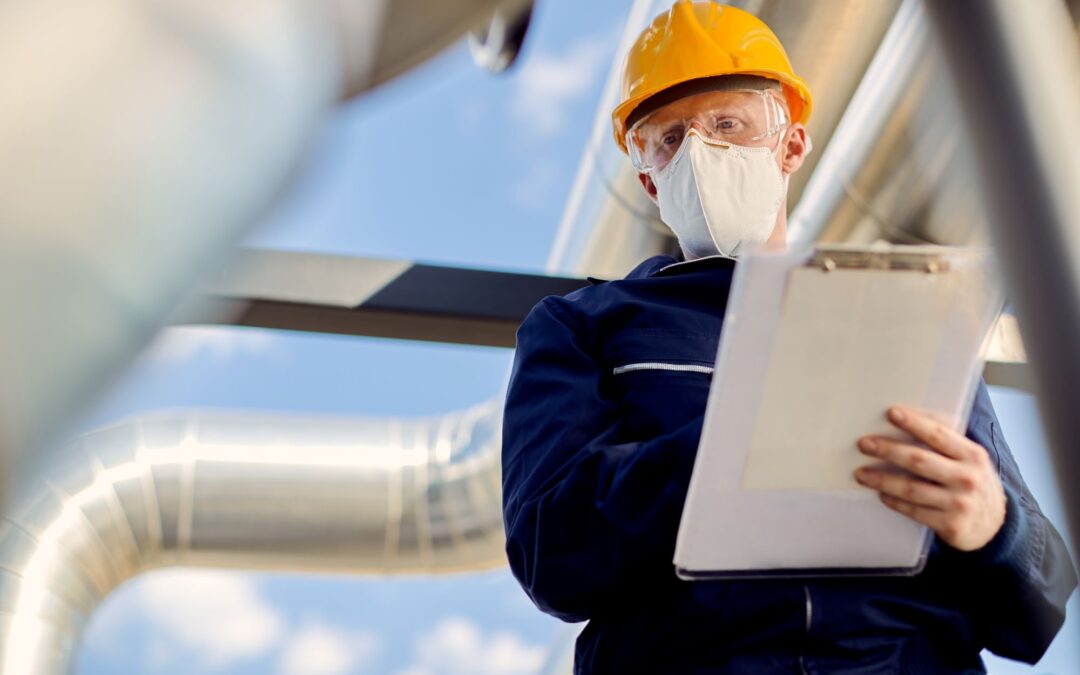In the oil and gas industry, working in confined spaces and exposure to hazardous gases, such as methane, hydrogen sulfide, and volatile organic compounds, pose significant risks to worker safety. To effectively mitigate these dangers, companies must implement robust gas detection and air quality monitoring systems that can quickly detect and alert employees to any potential issues. Moreover, adhering to the established guidelines and regulations is crucial for ensuring the safety of the workforce.
This comprehensive guide will delve into the vital components of gas detection and air quality monitoring in the oil and gas sector. We’ll discuss proper selection, utilization, and maintenance of gas detection equipment, as well as the significance of training and safety protocols. By understanding the relevance of gas detection and air quality measures, companies can effectively protect their workforce and maintain a safe working environment.
Identifying Gas Detection Hazards in the Oil and Gas Industry
A. Recognizing Hazardous Gas Sources: Identifying the potential sources of hazardous gases within your operations plays a critical role in ensuring safety. Understanding which areas pose risks, such as confined spaces, drilling operations, and storage facilities, can help develop proper safety measures and mitigate potential dangers.
B. Understanding Gas Detection Regulations: Compliance with safety regulations, such as those mandated by OSHA, is essential for implementing appropriate gas detection systems in the workplace. Companies must stay current with the latest guidelines and ensure their detection methods meet or exceed industry standards.
Types of Gas Detection Equipment for Oil and Gas Operations
A. Portable Gas Detectors: Portable gas detectors offer a flexible solution for detecting hazardous gases in various locations within the work environment. These devices can be quickly transported to different areas and are ideal for short-term monitoring or temporary work sites.
B. Fixed Gas Detection Systems: Fixed gas detection systems provide continuous monitoring of a designated workspace, ensuring an ongoing awareness of potential hazards. These systems are typically installed in strategic locations throughout the facility and can transmit real-time data to a central control room for monitoring purposes.
Selection and Utilization of Gas Detection Equipment
A. Assessing the Work Environment: Before selecting gas detection equipment for use in oil and gas operations, it’s crucial to thoroughly assess the work environment and potential hazards. This assessment helps determine the appropriate type and specifications of the detectors required to ensure optimal safety.
B. Calibration and Maintenance: To maintain the accuracy and effectiveness of gas detectors, regular calibration and maintenance are necessary. Companies should develop a comprehensive calibration schedule and have a maintenance plan in place to guarantee the reliability of their gas detection systems.
The Importance of Air Quality Monitoring
A. Detecting Oxygen Deficiency: In confined spaces, the risk of oxygen deficiency is a serious concern for workers’ safety. Air quality monitoring systems can be used to detect insufficient oxygen levels, allowing for immediate corrective measures to be taken.
B. Controlling Ventilation: Proper ventilation is essential for maintaining a safe work environment in the oil and gas industry. By closely monitoring air quality and adjusting ventilation accordingly, companies can minimize exposure to hazardous gases, ensuring the well-being of their workers.
Effective Training and Safety Procedures for Gas Detection
A. Comprehensive Gas Detection Training: Providing thorough training to workers on gas detection and air quality monitoring is crucial for their safety. Training should cover hazard identification, proper use of equipment, response procedures in case of a gas leak, and the importance of maintaining good air quality.
B. Standard Operating Procedures: Developing and implementing standard operating procedures (SOPs) for gas detection and air quality monitoring can help companies ensure that safety protocols are consistently followed. Clearly defined SOPs provide employees with guidelines that can be easily understood and put into practice.
Implementing Emergency Response and Evacuation Plans
A. Emergency Response Planning: Oil and gas operations should have an emergency response plan in place to address potential gas leaks or air quality issues. This plan should establish the roles and responsibilities of team members during an emergency and provide clear instructions on how to react in various scenarios.
B. Evacuation Procedures and Drills: Ensuring employees are aware of the proper evacuation procedures is crucial in the event of a serious gas leak or air quality incident. Conducting regular evacuation drills can help familiarize workers with the process and improve their ability to respond quickly and efficiently during a real emergency.
Integrating Gas Detection Systems with Other Safety Measures
A. Combining Detection Technologies: Integrating gas detection systems with other safety measures, such as fire suppression systems and ventilation controls, can ensure a more comprehensive approach to workplace safety. A connected approach helps address multiple hazards simultaneously, offering increased protection for workers.
B. Continuous Improvement and Technology Updates: Keeping up with the latest advancements in gas detection technology and updating equipment accordingly can be vital in maintaining the highest safety standards in oil and gas operations. Companies should be proactive in researching new methods and adopting innovative solutions to improve their safety systems.
The Benefits of a Robust Gas Detection and Air Quality Monitoring Program
A. Enhanced Employee Safety: Implementing a comprehensive gas detection and air quality monitoring program can significantly reduce the risk of hazardous gas exposure and other related incidents, ensuring employees remain safe in the workplace.
B. Improved Operational Efficiency: A safer work environment leads to increased worker confidence and productivity. By minimizing the risk of gas leaks and maintaining optimal air quality, oil and gas companies can experience better operational efficiency and reduced downtime due to safety incidents.
Auditing, Assessing, and Reporting Gas Detection and Air Quality Performance
A. Setting Performance Metrics: Establishing performance metrics, such as the frequency of gas leaks or air quality incidents, can help companies evaluate the effectiveness of their gas detection and air quality monitoring systems. By periodically reviewing these metrics, businesses can identify areas that require improvement and implement necessary changes.
B. Open Communication and Reporting: Companies should foster a work environment where employees feel comfortable discussing gas detection and air quality concerns openly. Encouraging workers to report any issues or near misses without fear of repercussions can lead to valuable insights that help improve overall safety.
Personal Protective Equipment (PPE) for Gas Hazards
A. Respiratory Protection: In situations where gas hazards cannot be effectively mitigated through engineering controls or administrative measures, proper respiratory protection is essential for ensuring worker safety. Companies should provide employees with appropriate respirators, such as half-mask or full-face respirators, depending on the severity of the hazard.
B. Protective Clothing and Gloves: Specialized protective clothing and gloves should be utilized when working in environments where hazardous gases may come into contact with the skin or cause damage to clothing. Companies must ensure workers are well-equipped with the necessary gear to minimize any risks associated with gas exposure.
Implementing Gas Detection and Air Quality Best Practices
A. Leverage Technology: Exploiting the latest in gas detection technology, such as wireless monitoring or real-time data analysis, enables companies to stay ahead of the curve in ensuring worker safety. By integrating these advanced solutions into their safety systems, businesses can maximize the effectiveness of their gas detection and air quality programs.
B. Continuous Improvement: A commitment to continuous improvement in the realm of gas detection and air quality monitoring is vital to maintain high safety standards. Regularly reviewing and updating practices, equipment, and training as new information or technologies become available can significantly enhance workplace safety.
Regulatory Compliance and Industry Standards
A. Adhering to Regulations: Compliance with federal, state, and industry-specific regulations related to gas detection and air quality is crucial to maintaining a safe work environment. Companies must monitor and follow the evolving guidelines issued by organizations like OSHA or ANSI to ensure their safety programs stay up to date.
B. Obtaining Certifications: Investing in certified gas detection and air quality equipment demonstrates a commitment to workplace safety. Companies should seek equipment with recognized certifications, ensuring that completed work meets or exceeds the established safety standards.
Future Innovations and Trends in Gas Detection and Air Quality Monitoring
A. Advanced Sensor Technology: The development of innovative sensor technologies and materials, such as nanotechnology or graphene-based sensors, holds great potential in enhancing the speed, accuracy, and sensitivity of gas detection equipment in the future.
B. Remote and Real-Time Monitoring: Embracing advancements in remote and real-time monitoring solutions provides oil and gas operations with crucial information to proactively respond to potential gas hazards and optimize workflows, ultimately creating a safer and more efficient working environment.
Offshore Gas Detection and Air Quality Challenges
A. Harsh Environments: Offshore oil and gas operations present specific challenges due to harsh environments, such as corrosive elements, high winds, and increased moisture levels. Companies must develop gas detection and air quality strategies that account for these unique conditions to ensure worker safety.
B. Specialized Equipment and Solutions: To maintain safety standards in offshore operations, companies should invest in specialized equipment designed for use in marine settings. This equipment should be made of corrosion-resistant materials and be capable of withstanding the constant movement of offshore platforms.
Evaluating the Implementation and Efficiency of Gas Detection and Air Quality Monitoring Systems
A. Return on Investment (ROI): An effective gas detection and air quality monitoring system provide numerous benefits, including reduced downtime, enhanced employee safety, and improved operational efficiency. By assessing the return on investment (ROI) of implemented systems, companies can justify the need for continuous improvements and investment in safety equipment.
B. Periodic Inspections and Audits: Conducting regular inspections and audits of gas detection and air quality systems helps ensure their effectiveness and identifies any potential issues. Keeping records of these inspections and implementing solutions to identified problems are vital to maintaining a continuously improving safety culture.
Sourcing Reliable Gas Detection and Air Quality Monitoring Equipment
A. Quality Assurance and Supplier Evaluations: When sourcing gas detection and air quality equipment, companies must perform thorough evaluations of potential suppliers. This includes researching the quality and reliability of products offered, as well as assessing the supplier’s reputation within the industry.
B. Ongoing Support and Product Updates: Establishing a strong working relationship with equipment suppliers ensures that companies receive ongoing support and product updates. This relationship enables access to the latest advancements and improvements, contributing to a safer and more efficient work environment.
Conclusion
Gas detection and air quality monitoring in the oil and gas industry are critical components of workplace safety. By understanding the specific hazards associated with gas exposure and implementing comprehensive safety measures, oil and gas companies can effectively protect their workforce and maintain a safe working environment.
With a dedicated commitment to utilizing state-of-the-art equipment, promoting open communication, and embracing a culture of continuous improvement, businesses can ensure the highest level of safety for their employees. At Tiger Safety Rentals, we specialize in providing safety services and equipment tailored to the unique needs of the oil and gas industry. Reach out to us to discuss how we can help you optimize your gas detection and air quality monitoring systems, enhance workplace safety, and contribute to the continued growth and success of your organization.

